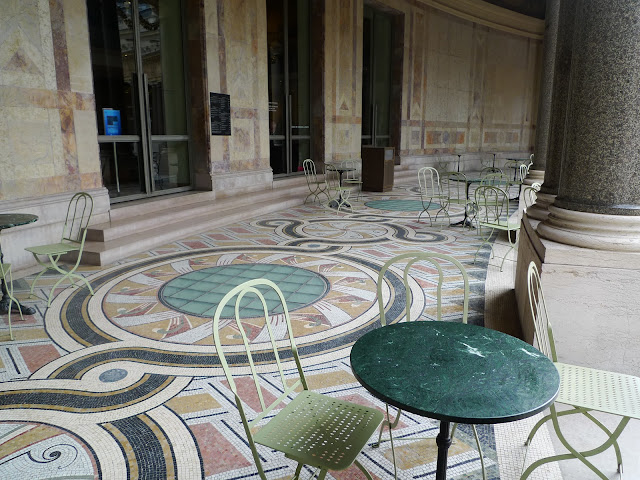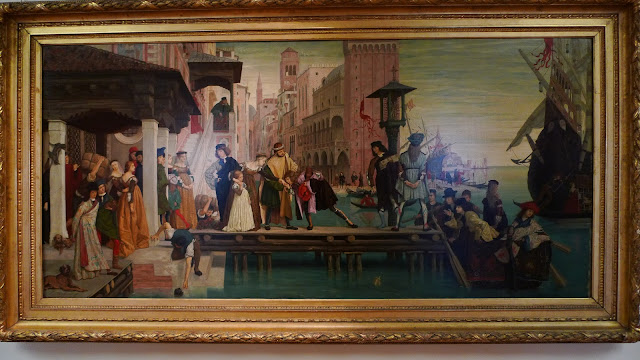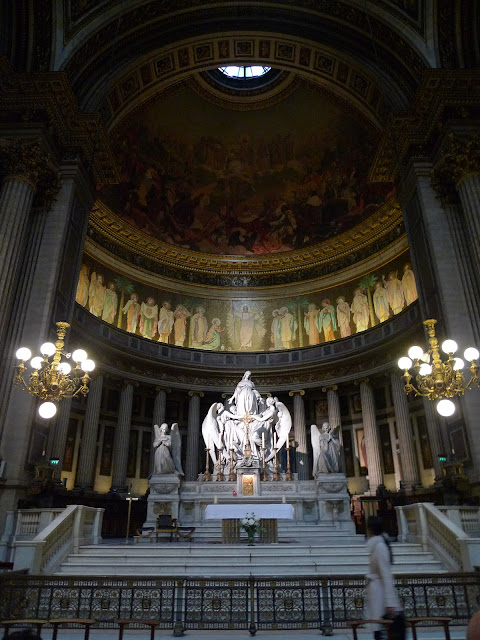For the tourist, as well as the locals, one of the best deals in Paris is to visit the Petit Palais - admission is free, except for the special exhibitions. Designed by Charles Girault and built for the universal exhibition in 1900, it now houses the permanent collection of the City of Paris Museum of Fine Arts (musée des beaux-arts de la ville de Paris).
"Petit Palais" means a small palace.
It is located on Avenue Winston Churchill, very near the Champs Elysées, across from the Grand Palais. Classic elements such as the ionic columns around the façade and the back, the dome,...
...and the grand porch are among the outstanding architectural features of this edifice, much like the other beautiful buildings around Paris.
As soon as you enter, explore with your eyes - all around - in the space, from the ceiling to the walls and to the floor. In between, you will find the intricate building's interior details and the art objects.
The courtyard is octi-circular in shape. Spring color is now abloom.
Among the landscape elements is this pond.
There is a place to sit and eat at the café restaurant. The outdoor sitting area is much desired by most on a lovely day.
Art objects are displayed indoors and outdoors and there are bronze statues scattered in this area. In this same picture, you can see the mosaic floor design. There are others just as beautiful in the other parts of the Petit Palais.
Look up and see the painted pattern on the ceiling.
This place fills up on good-weather days in the spring and summer, especially on the weekends. People come to meet, to walk around the courtyard and be delighted by the beauty around, or just to enjoy taking the sun. Then, some take the time to see the exhibitions, too. Alot two to three hours to visit.
Back inside, it is typical to see groups of school kids here taking a tour as part of their art immersion program in school. Toward the back is the bookstore, and to the right is the entry to the Tuck Collection of 18th century furniture and furnishings. Here's a sampling:
l'art de Louie XV
Chaise a porteurs 1700-1715
(gold-leafed wood, sculpted and painted)
A perspective view of the rest of the exhibit
Paravent 1735
Jacque de Lajoue
(Paris, 1686 - Paris, 1761)
Fauteuil à la reine vers 1760-1775
(Queen's armchair with the same theme as the set of tapestries)
Groupe Le marchand de coeurs vers 1738 -1750
Johann-Joachim Kändler
(Seligstadt ou Fischbach, 1706 - Meissen, 1775)
Ernest-Jules Renoux, artist
The objects he brought with him for outdoor painting: mounted parasol, leather/wooden stool, easel, canvass, water-color boxes, paint palett
It's time to descend to see the other collections.
The museum displays a remarkable number of collections - of paintings and sculptures and other works of art. There are paintings by Renaissance artists like Rembrandt, Rubens, Nicolas Poussin, Claude Gellee, Fragonard plus a host of others.
L'Enlevement de Prosephine vers 16-14-1615
Petrus-Paulus Rubens
(Siegen (Westphalie), 1577 - Anvers, 1640)
Le Massacre des Innocents vers 1626-1627
Nicolas Poussin
(Les Andelys, 1594 - Rome, 1665)
From the Dutuit Collection of medieval and Renaissance paintings, drawings and other objets d'art -
Doré et la tradition chrétienne XIXc collection:
La Vallée de Larmes
Gustave Doré
(Strasbourg, 1832 - Paris, 1883)
Le Christ
Léon Bonnat
(Bayonne, 1833 - Monchy-Saint-Eloi (Oise) 1922)
From the Renaissance Italie Collection
La Vierge et l'Enfant vers 1500-1504
Giovanni Battista Cima
(Conegliano, (?) 1459/1460 - Conegliano (?) 1517/1518)
 |
| Add caption |
Vierge a la l'Enfant avec sainte Dorothee, sainte Catharine et deux anges musiciens 1500
Ecole Lombard
From the Renaissance Italie Collection
La Vierge et l'Enfant, deux séraphins et la colombe du Saint Esprit
ATelier d'Andrea Della Robbia (Florence, 1435 - 1525)
And add to that some 19th century painters and sculptors including Ingres, Géricaul, Delacroix, Courbet, Monet, Isley, Pisarro, Cezanne, Modigliani, Carpeaux, Maillol, Rodin, and more.
From the Cezanne et la Modernité Paris 1900 collection:
Vieil Homme au Bâton
Paul Gaugin
(Paris, 1848 - Autona (Iles Marquises), 1903)
Baigneuses à Perros-Guirec
Maurice Denis
(Granville, 1870 - Saint Germain-en-Laye, 1943)
From the Monet et la Peinture Paysage XIXe Siècle Collection
Le Pont Royale et la Pavilion Flore
Camille Pisaro
(Saint-Thomas (Antilles Danoises) 1830 - Paris, 1903)
(Paris, 1939 - Moret-sur-Loing, 1989)
Claire de Lune à Overschie (environ de Rotterdam) 1855
Johann Bathold Jongkind
(Latrop Overijsel (Pays-Bas), 1819 - Saint-Egreve (Isère), 1891)
Soleil couchant sur la Seine a Lavacourt 1880
Claude Monet
(Paris, 1840 - Giverny (Eure), 1926)
Le Départ de l'enfant prodigue 1863
James Tissot
Nantes, 1836 - chateau de Buillon (Doubs), 1902
Le Retour de l'enfant prodigue 1862
James Tissot
(Nantes, 1836 - chateau de Buillon (Doubs), 1902)
Les Funérailles de Charles le Bon, comte de Flandre, célébrées a Bruges, en l'eglise SAint-Christophe, le 22 avril 1127 1876
Jan Van Beers
(Lierre (Belgique), 1852 - Fay-aux-Loges (Loiret), 1927)
La Confidence vers 1873
Jean-Baptists Carpeaux
(Valenciennes, 1827 - Courbevoie, 1875)
Guimard et l'Art nouveau Collection
Miss Ella Carmichaël 1906
Edmond Aman-Jean
(Chévry-Cossigny (Seine-et-Marne), 1858 - Paris, 1936)
The Petit Palais has the most extensive collective of icons. Here are a few pieces from the l'art de l'icon - Monde Chretienne Occidentale:
Vierge a l'Enfant avec saint Jean Baptiste, saint Bathélemy, sainte Madeleine et sainte Marguerite Florence XVe Siecle
Attributed to Ventura di Moro
Adoration des Mages fin du XVe siécle
Flandre
La Cène Greece
Moyenne Âge et Renaissance
Moyenne Âge et Renaissance
Left: La Nativite vers 1525
Attellier de Niklaus Wechmann
(Ulm, Allemagne du Sud)
Reliquaire de la Vraie Croix
Ssinte Marguerite vers 1520
(Sud de la Souabe, Allemagne)
Monde Grec Antiquité
Deux pleureuses Debut de 111e siécle avant J.C.
( Production: Canosa)
Cratére en calice ver 360e siécle avant J.C.
What I have featured here is just a minute fraction of what there is. There are, literaIly, hundreds and hundreds more. I apologize for the picture quality. The colors that came out were not always true colors due to the lighting and the reflection of the glass.
Art pieces are appreciated more up close as you analyze the strokes, the colors, the texture, the theme, and get more sense and feel of the artist as you look each piece. Art appreciation is the beholder's feedback - you finish the painting, the sculpture, or any other objets d'art with your thoughts and lasting impressions.
You can rent an audioguide or opt to join a guided tour. There are printed guides in most sections.
On exhibition now is Jean-Louis Forain (1852-19310 'la Comédie parisienne' from March 10 to June 5, 2011. Jean-Louis Forain was a satirist. He delivered his messages via his artistic expressions about the bourgeoisie and the less desirable aspects of Parisian society. The exhibition unveiled more than two hundred of his works in oil, watercolors, pastels, engravings and drawings. From Impressionism to Expressionism, his themes were most always about everyday life.
You are all invited to come and see this one.
Petit Palais
Avenue Winston Curchill 75008 Paris
Open Tuesday - Sunday, 10:00 a.m. - 6:00 p.m.
METRO Stop: Champs Elysées/Clemençeau













































































